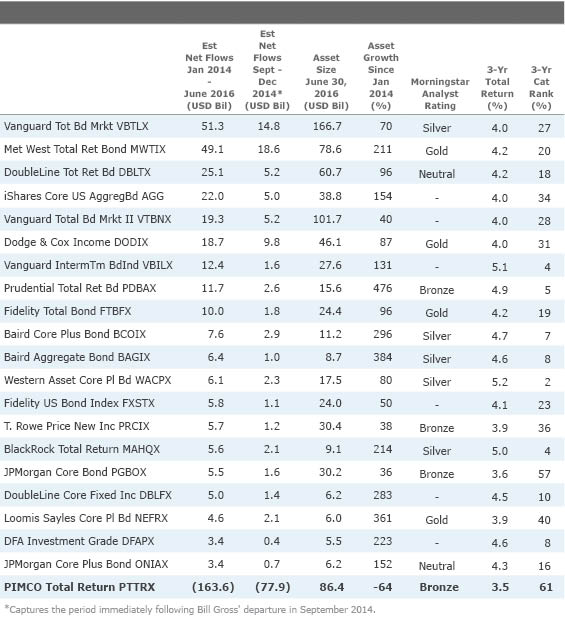Where Have PIMCO Total Return's Assets Gone?
These intermediate-term bond funds have grown the most as PIMCO's flagship has shrunk.
PIMCO's recent announcement that Manny Roman will become its new CEO comes after the firm has seen its assets under management decline by hundreds of billions since 2013. The appointment of Roman, who has been lauded for successfully stabilizing, diversifying, and growing Man Group's business as CEO, suggests that the firm is hoping he can pull off something similar here.
While some of PIMCO's strategies have been stable or even growing during this time, the firm's flagship
Where has all that money gone? We don't actually know where each of the dollars that left PIMCO Total Return have ended up. Some investors may have replaced their PIMCO Total Return allocation with another intermediate-term bond fund, but others may have left the category altogether or turned to another PIMCO strategy, such as the growing
Nonetheless, several intermediate-term bond funds have experienced extraordinary growth as PIMCO Total Return's assets have declined. Although the fund's outflow trend extends back to 2013, the so-called “taper tantrum” produced sharp losses for many funds, leading to widespread redemptions across the category that year. By early 2014, though, the category began to attract investors again, even as PIMCO Total Return's outflow trend remained steady and was about to accelerate. Since the beginning in 2014, when the asset flow trends of the intermediate-term bond category and PIMCO Total Return began to diverge, through June 2016, the following 20 intermediate-term bond funds (mutual funds and exchange-traded funds) have attracted the most assets.

- source: Morningstar Analysts
A few observations jump out from this table. One is the growth of
While those funds were already significant players in the intermediate-term bond category, a number of the group's smaller players have grown into heavyweights in recent years. Two funds run by the Milwaukee-based Baird Advisors,
On the bolder side, corporate-credit-heavy
While gains in market share among different active bond managers are worth noting, the most striking trend in the table demonstrates the ongoing shift from actively managed to index-tracking funds. The magnitude of the movement into index mutual funds and ETFs in this list stands out, totaling roughly $111 billion across funds run by Vanguard, iShares, and Fidelity, which happens to be just about two thirds the size of the asset flows out of PIMCO Total Return during this time. In April 2015, Vanguard Total Bond Market Index Fund surpassed PIMCO Total Return as the world's largest bond fund, and since the end of 2013, passive funds have grown from around a fourth of the assets in the intermediate-term bond category to more than a third as of June 2016.
In the years following the financial crisis, many market observers wrote off strategies that track the Barclays U.S. Aggregate Bond Index because of the bogy's generous allocation to low-yielding U.S. government bonds, a sentiment that stoked the popularity of unconstrained and other non-traditional-bond funds a few years ago. As it turns out, the Aggregate Bond Index has been tough to beat in recent years. That won't always be the case, but the relatively low price tags offered by these index funds give them a built-in edge over more-expensive intermediate-term bond peers, which is particularly useful when yields are lean. In the context of turmoil in the executive and investment-staff ranks at PIMCO, an index fund run by a reputable firm has one more advantage over its actively managed brethren: stability and consistency.


/cloudfront-us-east-1.images.arcpublishing.com/morningstar/HDPMMDGUA5CUHI254MRUHYEFWU.png)
/cloudfront-us-east-1.images.arcpublishing.com/morningstar/OMVK3XQEVFDRHGPHSQPIBDENQE.jpg)